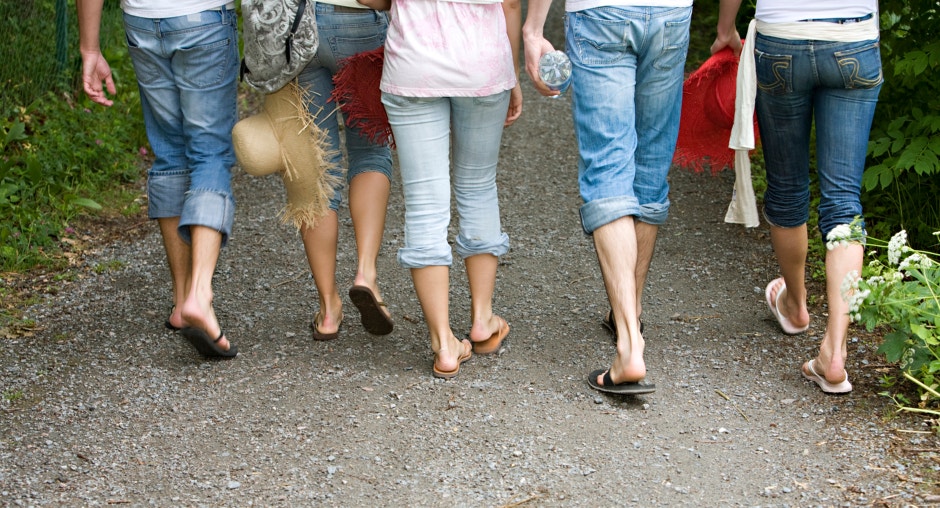8 Scary Reasons Flip-Flops Are Terrible For Your Feet, Says Science
Whoa. How did we not know this!?
 Getty
Getty You wear flip flops during warmer weather after getting a pedicure (we recommend the Yuzu pedicure at Eve Salon) and at the gym. If you're like me, you wear them all year-round, and while you have a whole bunch of them, you also have your favorites.
There's every kind of flip-flop imaginable, from artist designed to cheapo ones you can get at the drugstore. Flip-flops are so popular there's even a day of celebration for them (June 17)!
Flip-flops are super-cute and comfortable, but they can cause serious foot, hip, knee, and back injuries. Many foot doctors believe that flip-flops are the most dangerous shoes out there. Here are eight reasons flip-flops are bad for your feet.
1. You can get a Staph infection.
Anytime your feet get really dirty (like when you're been walking around on city streets) it's likely that there's more than just dirt covering your feet. One thing that could be lurking in that dirt layer is Staphylococcus (Staph). At the very least, staphylococcus will irritate the skin on your foot, but if you have a cut on your foot, the staphylococcus will seep in and enter your bloodstream. If left untreated it can lead to amputation or even death.
"Staph can make you pretty sick if it gets into a wound and into your blood, where it could attack any of your internal organs," Dennis Kinney, Ph.D., manager of the microbiology lab at EMSL Analytical, told the New York Daily News. "If you didn't treat it with antibiotics, you could die from it."
2. There could be thousands of types of bacteria on a pair of flip-flops.
With the help of the University of Miami Emergency Flip-flop Lab, TODAY tested flip-flops and found that there were more than 18,000 different types of bacteria on just one pair. Even more shocking than the number of germs were the types represented: bacteria from fecal matter (not just human but rat waste too), skin, respiratory (sick people spitting on the sidewalk), and vomit.
3. Don't forget the fungus and viruses.
If you wear flip-flops you have a good chance of coming into contact with a bad strain of Candida. Normally, your skin hosts a small amount of candida, but problems arise when it begins to multiply and create an overgrowth. But then you can also get a case of Athlete's foot (itchy, highly contagious fungal infection) or the virus that causes warts: human papillomavirus (HPV).
4. There's no protection for your feet.
If you're wearing flip-flops on a crowded subway or bus, you have a huge chance of somebody stepping on your vulnerable feet.
5. They change the way you walk.
An Auburn University study found people who wear flip-flops take smaller steps than people who wear athletic shoes. When you change your natural gait, your whole body must adjust and that can lead to issues in your ankles, knees, hips, and back.
6. You can get plantar fasciitis.
"These pancake flat shoes just don't give you the support or cushioning you need," says Dr. Kauderer, MD, a Brooklyn-based podiatrist, in an article on Health. Over time that lack of support can lead to plantar fasciitis, metatarsalgia, fallen arches and bone spurs.
7. They destroy your toes.
Over-wearing your flip-flops can lead to hammer toes (a contraction of the joints that cause the toe to bend abnormally), and encourage bunion formation or make an existing bunion worse. Both of these conditions can be painful.
"You're taking your five toes and grabbing your shoe to make sure it doesn't slide out," said Bob Thompson, the Executive Director of the Institute for Preventative Foot Health in an interview with Medical Daily.
8. You're more prone to blisters.
With flip-flops, the only thing holding them on are the straps that go between your toes, which rubs against your skin every time you take a step. Over time, this can cause irritation and blisters. When a blister pops, you're left with an open wound and a welcome sign for all that bacteria and fungus that's running around. If your blister gets infected you could have further complications as cellulitis and sepsis (which can be life-threatening).
The repercussions of wearing flip-flops can be very serious and long-lasting. It's OK to wear flip-flops when you're walking out to the pool or using them in the shower at the gym, but do your feet a favor and buy yourself some proper footwear. Your feet will thank you.
